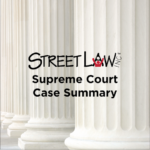In this lesson, students will learn how state legislatures and governors can manipulate the redistricting process to gain an advantage for their party in the U.S. House of Representatives and state legislatures. Students will learn what constitutes gerrymandering and the typical types of gerrymandering used. Students will role play state legislators and collaborate to draw both gerrymandered and not gerrymandered districts. Students will consider the foundational redistricting case Baker v. Carr (1962) and classify arguments made in the case. In addition, students will evaluate the proper role of the Supreme Court in state redistricting cases.
Shaw v. Reno (1993)
Did the North Carolina residents’ claim that the 1990 redistricting plan discriminated on the basis of race raise a valid constitutional issue under the 14th Amendment’s Equal Protection Clause? North Carolina drew legislative districts to create a majority black district.
Baker v. Carr (1962)
Do federal courts have the power to decide cases about the apportionment of population into state legislative districts? This case relates to voting equality- one person’s vote should be as meaningful as another’s.
Evenwel v. Abbott (2016)
Does the principle of “one person, one vote” permit states to use total population rather than total voter population when apportioning legislative districts? This case summary explores this question and the principle of one person, one vote, in this case about drawing district lines.
